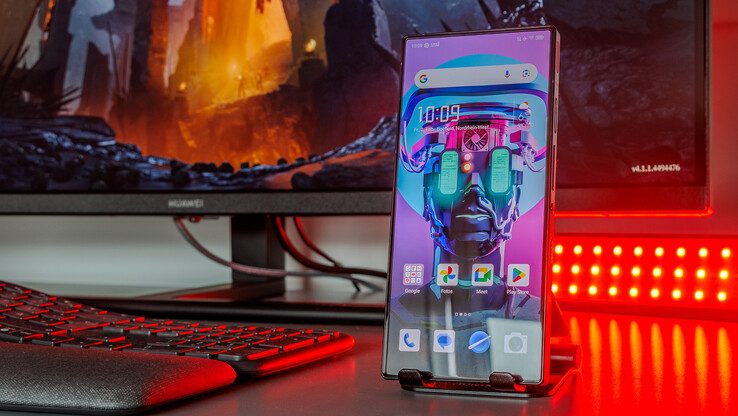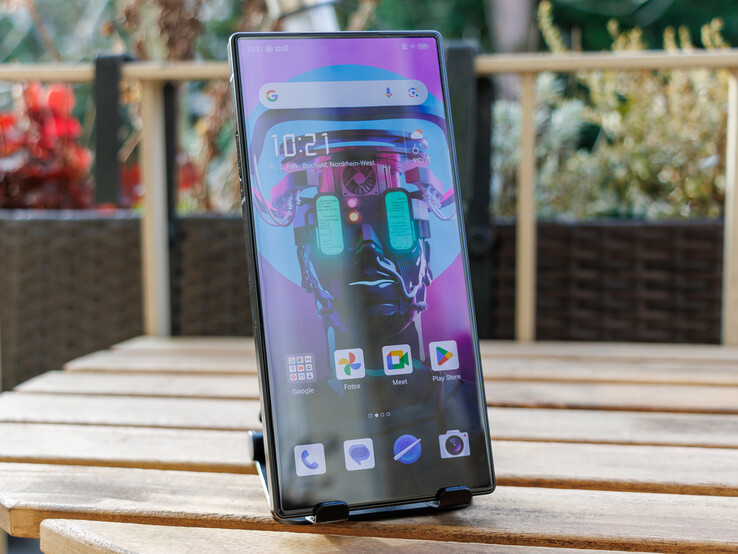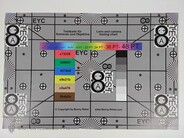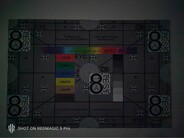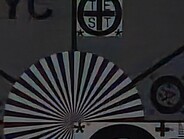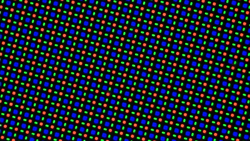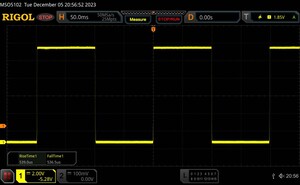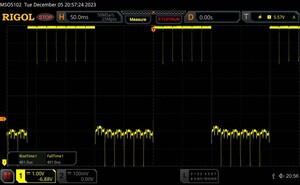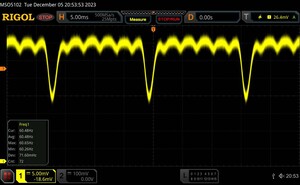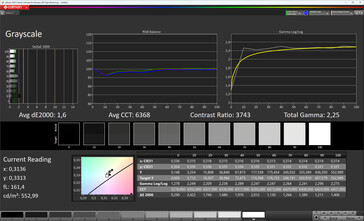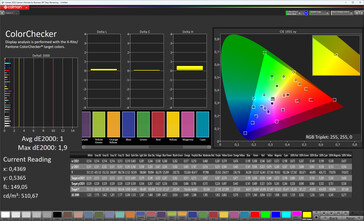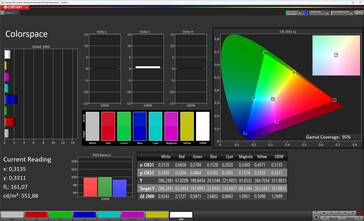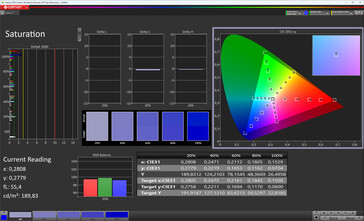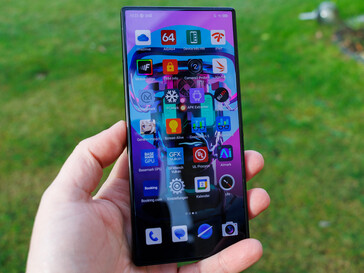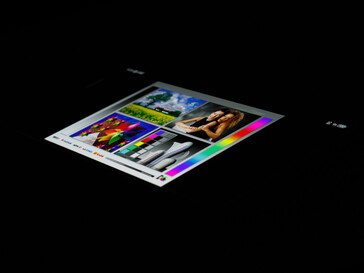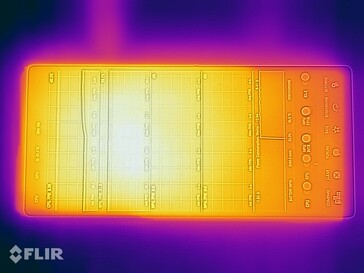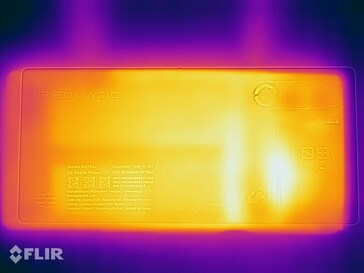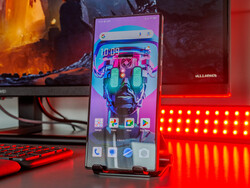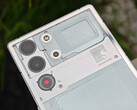Nubia RedMagic 9 Pro review - Blazingly fast gaming phone with a stylish design
Comparison with possible competitors
Bewertung | Datum | Modell | Gewicht | Laufwerk | Groesse | Aufloesung | Preis ab |
|---|---|---|---|---|---|---|---|
| 86.8 % v7 (old) | 02 / 2024 | Nubia RedMagic 9 Pro SD 8 Gen 3, Adreno 750 | 229 g | 512 GB UFS 4.0 Flash | 6.80" | 2480x1116 | |
| 88.3 % v7 (old) | 08 / 2023 | Nubia RedMagic 8S Pro SD 8 Gen 2, Adreno 740 | 228 g | 512 GB UFS 4.0 Flash | 6.80" | 2480x1116 | |
| 87.4 % v7 (old) | 01 / 2024 | Xiaomi Poco F5 Pro SD 8+ Gen 1, Adreno 730 | 204 g | 256 GB UFS 3.1 Flash | 6.67" | 3200x1440 | |
| 88.6 % v7 (old) | 02 / 2024 | Asus ROG Phone 8 Pro SD 8 Gen 3, Adreno 750 | 225 g | 1 TB UFS 4.0 Flash | 6.78" | 2400x1080 |
Case and features - Seamless viewing experience
The Nubia RedMagic 9 Pro is very angular and calls to mind the design of its predecessor. The device is well balanced and sits well in the hand despite being fairly heavy. It is available in the colourways Sleet (black), Cyclone (translucent back) and Snowfall (silver-white).
We like the 9 Pro’s built quality: all the gaps on the phone are small and even. It once again has a seamless display with the front camera hidden beneath the panel. The under-display camera is meanwhile virtually invisible and can only be located when you view it from certain angles with lots of light shining on the display. The rear cameras are flush with the phone's body – something you don’t see often nowadays. They are likewise covered by an unspecified glass.
The gaming phone doesn’t have any IP certification, but the sealed SIM slot suggests that there is at least some basic protection against splashing water.
The phone is similar to its predecessor when it comes to features. On the right side of the phone, you'll once again find two touch-sensitive dedicated triggers. They provide good haptic feedback and feel very responsive during gaming.
The integrated USB port not only delivers high data transfer speeds (copy test: 635.9 MB/s) but also supports video output via a cable. This means you can easily mirror the screen or load up a desktop version of RedMagic Game Space (up to Full HD and 144Hz).
Connectivity, software and operation
The Nubia RedMagic 9 Pro supports all conventional mobile communications standards with a wide frequency coverage. Wireless LAN connectivity is really snappy and stable with Wi-Fi 7 as well as in both the 5.0 GHz and 6.0 GHz range.
The phone offers decent voice quality as long as you hold it to your ear. That said, noise suppression is average at best, and the RedMagic sounds slightly echoey in speaker mode.
For operating system, the phone comes with Android 14 with Nubia’s RedMagic OS 9.0 custom UI. At the time of review, the security patches were dated 1 November 2023 and thus no longer completely up to date. Based on experience, updates are only rolled out sporadically. Nubia has merely promised to provide one major update and two years of security patches.
Biometric security is handled by an in-display optical fingerprint scanner that does its job adequately and can measure heart rate to boot. Alternatively or additionally, you can use facial recognition via the front camera, but this method is less secure.
Apart from the two extra capacitive shoulder triggers, there is a striking, red button built into the frame that lets you switch to a special gaming interface on the phone: the RedMagic Game Space. It lets users customise settings for individual games and manage any paired accessories.
| Networking | |
| iperf3 transmit AXE11000 | |
| Nubia RedMagic 9 Pro | |
| Xiaomi Poco F5 Pro | |
| Nubia RedMagic 8S Pro | |
| Asus ROG Phone 8 Pro | |
| iperf3 receive AXE11000 | |
| Nubia RedMagic 9 Pro | |
| Xiaomi Poco F5 Pro | |
| Nubia RedMagic 8S Pro | |
| Asus ROG Phone 8 Pro | |
| iperf3 transmit AXE11000 6GHz | |
| Xiaomi Poco F5 Pro | |
| Asus ROG Phone 8 Pro | |
| Nubia RedMagic 9 Pro | |
| Nubia RedMagic 8S Pro | |
| iperf3 receive AXE11000 6GHz | |
| Nubia RedMagic 8S Pro | |
| Nubia RedMagic 9 Pro | |
| Asus ROG Phone 8 Pro | |
| Xiaomi Poco F5 Pro | |
Cameras - Better dual camera, weak front camera
Nothing much has changed with the front camera. The under-display camera has a beauty mode at its disposal, but images still look muddy and lack detail even when this function is disabled. Pictures also quickly become extremely noisy in low-light conditions.
The main camera module now has one lens fewer than its predecessor. The wide-angle sensor is identical to the one on the RedMagic 8S Pro but now has optical image stabilisation (OIS). The second lens has 50 MP as well and can be used to take both ultra-wide and macro images. Whilst lacking any optical zoom, the phone is capable of up to ten times digital zoom. Photos taken with the RedMagic 9 Pro have a nice level of detail but look somewhat washed-out and dull.
You can record videos at up to 8K (30 fps) with the main shooter and Full HD (30 fps) with the front camera.
Image comparison
Choose a scene and navigate within the first image. One click changes the position on touchscreens. One click on the zoomed-in image opens the original in a new window. The first image shows the scaled photograph of the test device.
Main cameraMain cameraUltra-wide angle5x zoomLow-light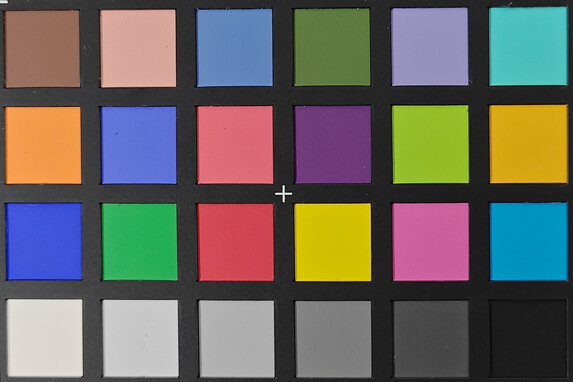
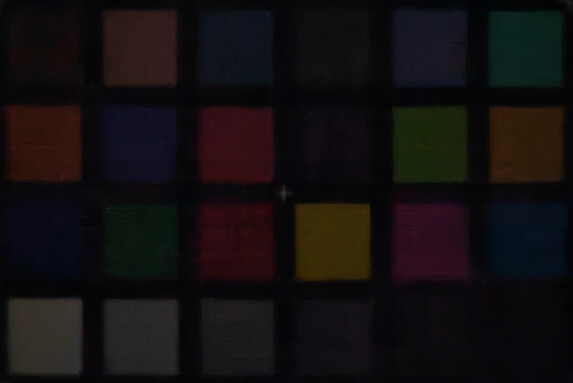
Display - Bright AMOLED in the RedMagic 9 Pro
In terms of general specs, the display on the RedMagic 9 Pro remains unchanged from the previous generation: it's a 6.8-inch Full HD+ panel capable of up to 120Hz refresh rate. Though colour accuracy and brightness have been further improved.
With the ambient light sensor enabled, the AMOLED display hit an average peak brightness of 1,031 cd/m² whilst showing a completely white image. When bright and dark areas are distributed evenly (APL 18), the panel even managed to get as bright as 1,242 cd/m². It also reached a similar level for HDR playback. The display has a manual max brightness of 589 cd/m².
Like all OLED panels, the screen on RedMagic 9 Pro isn't spared from flickering either. That said, Nubia uses high-frequency PWM dimming at 2,160Hz to make the display as comfortable to the eye as possible.
| |||||||||||||||||||||||||
Brightness Distribution: 96 %
Center on Battery: 1035 cd/m²
Contrast: ∞:1 (Black: 0 cd/m²)
ΔE ColorChecker Calman: 1 | ∀{0.5-29.43 Ø4.78}
ΔE Greyscale Calman: 1.6 | ∀{0.09-98 Ø5}
99.5% sRGB (Calman 2D)
Gamma: 2.25
CCT: 6368 K
| Nubia RedMagic 9 Pro BOE Q9+, AMOLED, 2480x1116, 6.8" | Nubia RedMagic 8S Pro AMOLED, 2480x1116, 6.8" | Xiaomi Poco F5 Pro AMOLED, 3200x1440, 6.7" | Asus ROG Phone 8 Pro OLED, 2400x1080, 6.8" | |
|---|---|---|---|---|
| Response Times | -116% | -21% | -27% | |
| Response Time Grey 50% / Grey 80% * (ms) | 0.8 ? | 2.06 ? -158% | 1.09 ? -36% | 1.18 ? -48% |
| Response Time Black / White * (ms) | 1.08 ? | 1.88 ? -74% | 1.13 ? -5% | 1.14 ? -6% |
| PWM Frequency (Hz) | 60 | 60 | 120.3 | 485 |
| Screen | -21% | 6% | -30% | |
| Brightness middle (cd/m²) | 1035 | 775 -25% | 1002 -3% | 1699 64% |
| Brightness (cd/m²) | 1031 | 778 -25% | 1004 -3% | 1698 65% |
| Brightness Distribution (%) | 96 | 98 2% | 95 -1% | 98 2% |
| Black Level * (cd/m²) | ||||
| Colorchecker dE 2000 * | 1 | 1.3 -30% | 0.8 20% | 1.9 -90% |
| Colorchecker dE 2000 max. * | 1.9 | 2.4 -26% | 1.7 11% | 4.7 -147% |
| Greyscale dE 2000 * | 1.6 | 1.9 -19% | 1.4 12% | 2.8 -75% |
| Gamma | 2.25 98% | 2.28 96% | 2.23 99% | 2.26 97% |
| CCT | 6368 102% | 6693 97% | 6468 100% | 6648 98% |
| Total Average (Program / Settings) | -69% /
-44% | -8% /
-1% | -29% /
-29% |
* ... smaller is better
Display Response Times
| ↔ Response Time Black to White | ||
|---|---|---|
| 1.08 ms ... rise ↗ and fall ↘ combined | ↗ 0.539 ms rise | |
| ↘ 0.5365 ms fall | ||
| The screen shows very fast response rates in our tests and should be very well suited for fast-paced gaming. In comparison, all tested devices range from 0.1 (minimum) to 240 (maximum) ms. » 4 % of all devices are better. This means that the measured response time is better than the average of all tested devices (20.2 ms). | ||
| ↔ Response Time 50% Grey to 80% Grey | ||
| 0.8 ms ... rise ↗ and fall ↘ combined | ↗ 0.4015 ms rise | |
| ↘ 0.401 ms fall | ||
| The screen shows very fast response rates in our tests and should be very well suited for fast-paced gaming. In comparison, all tested devices range from 0.165 (minimum) to 636 (maximum) ms. » 2 % of all devices are better. This means that the measured response time is better than the average of all tested devices (31.6 ms). | ||
Screen Flickering / PWM (Pulse-Width Modulation)
| Screen flickering / PWM detected | 60 Hz | ||
The display backlight flickers at 60 Hz (worst case, e.g., utilizing PWM) . The frequency of 60 Hz is very low, so the flickering may cause eyestrain and headaches after extended use. In comparison: 53 % of all tested devices do not use PWM to dim the display. If PWM was detected, an average of 8111 (minimum: 5 - maximum: 343500) Hz was measured. | |||
Performance, emissions and battery life
The Nubia RedMagic 9 Pro is one of the first smartphones available globally to feature the Qualcomm Snapdragon 8 Gen 3. Thanks to the built-in fan, which runs even quieter (max. 39 dB(A)) than the one in the 8S Pro, the phone is able to keep the processor running stably at peak performance most of the time.
In our browser benchmarks, we noticed that the RedMagic phone and Chrome don’t play particularly well together. Results were surprisingly poor when Google’s browser was used. Things were different when we used Microsoft Edge, for example.
We ran the Burnout benchmark (CPU + GPU) to simulate a heavy load. The RedMagic 9 Pro crashed after about ten minutes and required a restart. The device overheated despite having a fan. Subsequent measurements were thus carried out with only CPU load enabled. Even so, the gaming phone became very hot.
The two speakers on the RedMagic 9 Pro can get really loud, but they already sound tinny and empty at moderate volume levels.
The Nubia phone truly shines when it comes to battery life. The battery has a whopping 6,500 mAh capacity and lasted an outstanding 17 hours in our Wi-Fi test.
| Octane V2 - Total Score | |
| Nubia RedMagic 9 Pro (Edge 120) | |
| Nubia RedMagic 9 Pro (Chrome 120) | |
| Asus ROG Phone 8 Pro (Edge 121.0.2277.84) | |
| Xiaomi Poco F5 Pro (Chrome 120.0.6099.115) | |
| Xiaomi 14 Pro (Chrome 120) | |
| Average Qualcomm Snapdragon 8 Gen 3 (25953 - 75238, n=27) | |
| Nubia RedMagic 8S Pro (Edge 115) | |
| Nubia RedMagic 8S Pro (Chrome 115) | |
| Average of class Smartphone (2228 - 121337, n=201, last 2 years) | |
Basemark GPUScore
| Nubia RedMagic 9 Pro | Nubia RedMagic 8S Pro | Xiaomi Poco F5 Pro | Asus ROG Phone 8 Pro | Average 512 GB UFS 4.0 Flash | Average of class Smartphone | |
|---|---|---|---|---|---|---|
| AndroBench 3-5 | -19% | -42% | -3% | -16% | -44% | |
| Sequential Read 256KB (MB/s) | 4164.08 | 3576.35 -14% | 1876.8 -55% | 4016.67 -4% | 3675 ? -12% | 2216 ? -47% |
| Sequential Write 256KB (MB/s) | 3199.98 | 2682.03 -16% | 1773.94 -45% | 3153.4 -1% | 3072 ? -4% | 1837 ? -43% |
| Random Read 4KB (MB/s) | 442.82 | 369.76 -16% | 342.04 -23% | 434.63 -2% | 382 ? -14% | 294 ? -34% |
| Random Write 4KB (MB/s) | 691.17 | 479.52 -31% | 372.35 -46% | 648 -6% | 463 ? -33% | 334 ? -52% |
Temperature
(-) The maximum temperature on the upper side is 55.1 °C / 131 F, compared to the average of 35.2 °C / 95 F, ranging from 21.9 to 247 °C for the class Smartphone.
(-) The bottom heats up to a maximum of 51.6 °C / 125 F, compared to the average of 34 °C / 93 F
(+) In idle usage, the average temperature for the upper side is 24.5 °C / 76 F, compared to the device average of 32.9 °C / 91 F.
3DMark Wild Life Stress Test
Nubia RedMagic 9 Pro audio analysis
(+) | speakers can play relatively loud (91.7 dB)
Bass 100 - 315 Hz
(-) | nearly no bass - on average 22.3% lower than median
(+) | bass is linear (5.1% delta to prev. frequency)
Mids 400 - 2000 Hz
(+) | balanced mids - only 4% away from median
(+) | mids are linear (5.3% delta to prev. frequency)
Highs 2 - 16 kHz
(+) | balanced highs - only 4.8% away from median
(+) | highs are linear (3.5% delta to prev. frequency)
Overall 100 - 16.000 Hz
(±) | linearity of overall sound is average (16.7% difference to median)
Compared to same class
» 8% of all tested devices in this class were better, 6% similar, 86% worse
» The best had a delta of 11%, average was 35%, worst was 134%
Compared to all devices tested
» 28% of all tested devices were better, 7% similar, 65% worse
» The best had a delta of 4%, average was 24%, worst was 134%
Asus ROG Phone 8 Pro audio analysis
(+) | speakers can play relatively loud (92.2 dB)
Bass 100 - 315 Hz
(-) | nearly no bass - on average 21.2% lower than median
(+) | bass is linear (4.8% delta to prev. frequency)
Mids 400 - 2000 Hz
(±) | reduced mids - on average 5.1% lower than median
(+) | mids are linear (4.2% delta to prev. frequency)
Highs 2 - 16 kHz
(±) | higher highs - on average 5.6% higher than median
(+) | highs are linear (3.3% delta to prev. frequency)
Overall 100 - 16.000 Hz
(±) | linearity of overall sound is average (17.3% difference to median)
Compared to same class
» 11% of all tested devices in this class were better, 8% similar, 81% worse
» The best had a delta of 11%, average was 35%, worst was 134%
Compared to all devices tested
» 31% of all tested devices were better, 8% similar, 60% worse
» The best had a delta of 4%, average was 24%, worst was 134%
| Battery Runtime - WiFi Websurfing | |
| Average of class Smartphone (12.1 - 54.1, n=212, last 2 years) | |
| Nubia RedMagic 9 Pro | |
| Nubia RedMagic 8S Pro | |
| Xiaomi Poco F5 Pro | |
| Asus ROG Phone 8 Pro | |
Pros
Cons
Verdict
The Nubia RedMagic 9 Pro is a minor step forward from its predecessor, the 8S Pro. Familiar highlights such as configurable LEDs and extra shoulder buttons are once again on board and essentially unchanged. Besides having the latest Qualcomm SoC, the gaming phone also offers a brighter display, a quieter fan and a larger battery. The new camera setup has been improved as well. Furthermore, the phone can now charge at up to 80 watts.
The RedMagic 9 Pro is a powerful gaming phone with a small price tag. But it can get very hot.
Though it’s nice that the fan now runs quieter, the cooling solution wasn't enough to keep the phone from shutting down during our stress test. Nubia would do well to throttle the SoC slightly rather than going for all-out performance. Whilst overheating isn’t an issue when gaming, surface temperatures can run high.
A handful of features are also missing, such as wireless charging and IP certification, both of which can be overlooked given the product’s focus. However, a device in this price range should have eSIM support.
The Asus ROG Phone 8 Pro is the RedMagic 9 Pro’s toughest competitor. If you mostly care about performance, other high-end smartphones may likewise be great alternatives for you, not least the Nubia Z60 Ultra.
Price and availability
The Nubia RedMagic 9 Pro is available in three configurations:
| Colour | RAM/Storage | Price (RRP) |
|---|---|---|
| Sleet | 12/256 GB | €649/US$649 |
| Cyclone | 16/512 GB | €799/US$799 |
| Snowfall | 16/512 GB | €799/US$799 |
All models can be ordered directly from the manufacturer's website or from Amazon.
Nubia RedMagic 9 Pro
- 02/05/2024 v7 (old)
Daniel Schmidt
Transparency
The selection of devices to be reviewed is made by our editorial team. The test sample was provided to the author as a loan by the manufacturer or retailer for the purpose of this review. The lender had no influence on this review, nor did the manufacturer receive a copy of this review before publication. There was no obligation to publish this review. As an independent media company, Notebookcheck is not subjected to the authority of manufacturers, retailers or publishers.
This is how Notebookcheck is testing
Every year, Notebookcheck independently reviews hundreds of laptops and smartphones using standardized procedures to ensure that all results are comparable. We have continuously developed our test methods for around 20 years and set industry standards in the process. In our test labs, high-quality measuring equipment is utilized by experienced technicians and editors. These tests involve a multi-stage validation process. Our complex rating system is based on hundreds of well-founded measurements and benchmarks, which maintains objectivity. Further information on our test methods can be found here.




